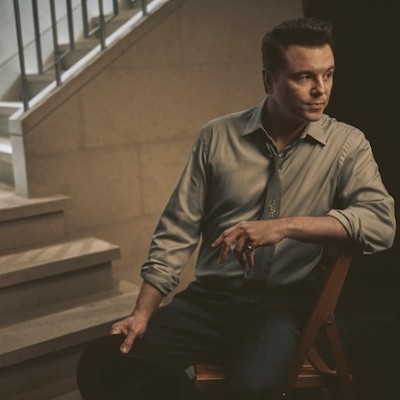Dec 9, 2025 12:28 PM
In Memoriam: Gordon Goodwin, 1954–2025
Gordon Goodwin, an award-winning saxophonist, pianist, bandleader, composer and arranger, died Dec. 8 in Los Angeles.…

Billy Childs’ work with the Dorian Wind Quintet served as a turning point in his writing.
(Photo: Raj Naik)5th Street Dick’s was a neighborhood coffee shop and venue in Los Angeles—now closed for about 20 years—where folks would sit outside to play chess, sip drinks and eat pastries, while pianist Billy Childs was up on the building’s second floor, investigating his expansive view of what music could and should be. “Leimert Park was an inspiring environment to be in. It gave me a lot of ideas of how I can combine poetry with music,” Childs said about the L.A. neighborhood that inspired and provided the title for a track on Acceptance (Mack Avenue), an eight-song program that just about perfectly renders his artistic berth. The recording isn’t so much an assemblage of storied moments, but rather a recasting of some of the bandleader’s older compositions, set alongside fresh ruminations.
“I would go [to 5th Street Dick’s] on Saturday nights, and I would play there with this group called the Underground Railroad, which was led by a guy named JMD—Darryl Moore,” Childs, 63, recalled. “He was a drummer, and he put this collection of musicians together to act kind of as a house band for MCs to come up and freestyle.”
Among the performers Childs supported were two members of Freestyle Fellowship—Aceyalone and Mikah 9—a group that JMD helped produce and one that decades later still would be remembered for helping to define an underground aesthetic that prized knotty rhymes filled with artful references to sociopolitical ideas. Chick Corea and Bennie Maupin, the pianist said, dropped by to jam at various points, too. While Childs’ composition “Leimert Park” doesn’t actually reference hip-hop—nor does most of his work—the song easily ranks as the new album’s most funky cut, featuring phased keyboards and heavy percussion.
“I wrote the song with Mike Clark and Paul Jackson, who kind of changed music—kind of changed the idea of jazz-funk,” Childs said about the drummer and bassist, respectively, who played on Herbie Hancock’s 1974 LP Thrust. For Acceptance, Childs recruited drummer Eric Harland, bassist Hans Glawischnig and reedist Steve Wilson to back him. “It has a very ’70s feel, and that ’70s feel is reminiscent of what they used to do with Herbie. But it also reminded me of Leimert Park in the mid-’90s.”
Southern California’s music scene, perhaps mimicking its sprawl, seems to shun boundaries, whether it was the embrace of beat music and wayward jazz at 5th Street Dick’s or the West Coast Get Down’s more recent disregard for genre adherence. An L.A. native, Childs has built a body of work just as broad, one that spans generations and effortlessly encompasses the classical world, too.
“There’s a very solid classical music scene in New York, but it has this huge tradition behind it and huge legacy. You could look at it like it’s weighted down by the baggage of the legacy, and therefore, you’re entrenched in only one thing,” Childs said over Zoom from his home in Southern California during late June. “So, here in Los Angeles, there wasn’t a lot of that happening. And also there was a big studio scene here. So, if you studied classical violin, your hope for employment would be the studio scene ... .
“If you’re [a classical musician] in a studio, you have to be able to play with a drum set, you have to be able to play with a click track. You have to be able to play different genres of music. So, there’s more interaction between the genres. And it makes it easier for someone like me, who’s a composer, to create music that combines genres. There’s no attitude, from either side, about [the music being] too classical or too jazzy. I grew up with that ethos, and I was able to experiment and learn a lot about combining genres.”
Abundance might be the defining quality of Childs’ career. Whether it’s the breadth of music history his work can encompass on any given album—or really, any given song—the stories he tells through composition or his endless and unerring cast of collaborators, there seems to be nothing but a desire to continue opening up the music, stretching toward new creative horizons.
In 2017, Childs endeavored to again fully embrace jazz on his Mack Avenue debut, Rebirth, a disc that earned him his fifth Grammy. During a 40-year career, he’d never really left the music behind, but his connections to the Kronos Quartet and the Los Angeles Philharmonic, as well as time spent with bandleaders like trumpeter Chris Botti, had pulled focus from Childs’ leader dates, which stretch back to his 1985 debut, Midland. But it was Child’s engagement with the vastness of other musics that led to a deeper connection with the notes on the page.
“The Dorian Wind Quintet—their manager had called me, and they were looking for someone to compose a piece for piano and wind quintet,” Childs recalled about a moment in the ’90s. “I knew that they were one of the oldest and most respected wind quintets on the scene, so it was a huge honor for me, and I wrote this piece called A Day In The Forest Of Dreams, and it’s in two movements. ... It was a challenging piano part, challenging for the ensemble, because it was very rhythmically complex and had a lot of counterpoint. So, I had to go to New York to rehearse it.
“I get there, and when they break out the music and we’re going over it, someone said something like, ‘In measure 43, does that phrase extend from the “and” of 2 to beat 3 of measure 44, or does it go to measure 45, beat 1?’ I had no clue how to answer that, because I had just written the notes. I think I made up something: You know, ‘Go to measure 45.’ But what it did was it made me realize that I had to know every reason that I wrote every note. And it made me really pay attention to the details of the music. When I started rehearsing with them, they were very particular about breathing together, about volume and dynamics, about the phrase, about the meaning of the phrase, about how this phrase affected that one. I had never thought of music in that much detail, so it made me want to transfer that to a jazz situation. That was kind of the beginning of my jazz-chamber concept.”

Goodwin was one of the most acclaimed, successful and influential jazz musicians of his generation.
Dec 9, 2025 12:28 PM
Gordon Goodwin, an award-winning saxophonist, pianist, bandleader, composer and arranger, died Dec. 8 in Los Angeles.…

Flea has returned to his first instrument — the trumpet — and assembled a dream band of jazz musicians to record a new album.
Dec 2, 2025 2:01 AM
After a nearly five-decade career as one of his generation’s defining rock bassists, Flea has returned to his first…

“It’s a pleasure and an honor to interpret the music of Oscar Peterson in his native city,” said Jim Doxas in regard to celebrating the Canadian legend. “He traveled the world, but never forgot Montreal.”
Nov 18, 2025 12:16 PM
In the pantheon of jazz luminaries, few shine as brightly, or swing as hard, as Oscar Peterson. A century ago, a…

Dec 11, 2025 11:00 AM
DownBeat presents a complete list of the 4-, 4½- and 5-star albums from 2025 in one convenient package. It’s a great…

Seth MacFarlane takes a turn from his television and film career to sing arrangements made for Frank Sinatra, but never recorded.
Nov 18, 2025 12:04 PM
“I’m not gonna lie to you — I don’t know why I thought this was about The Naked Gun, but I’m happy it’s…